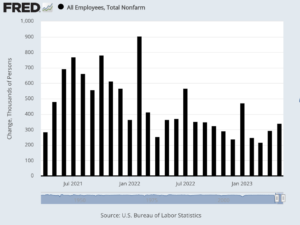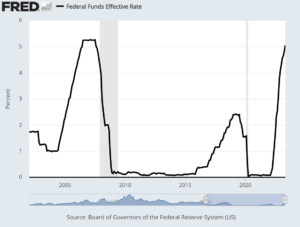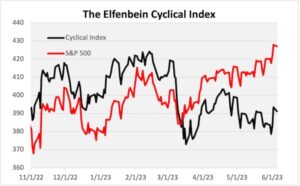CWS Market Review – June 6, 2023
(This is the free version of CWS Market Review. If you like what you see, then please sign up for the premium newsletter for $20 per month or $200 for the whole year. If you sign up today, you can see our two reports, “Your Handy Guide to Stock Orders” and “How Not to Get Screwed on Your Mortgage.”)
The Economy Added 339,000 Jobs in May
On second thought, maybe the economy isn’t about to go into a recession. At least, not according to the jobs market.
On Friday, the government said that the U.S. economy created 339,000 net new jobs last month. That was well above Wall Street’s forecast of 190,000. This was the 29th month in a row of job creation. The numbers for March and April were revised higher as well.
As a general rule of thumb, the U.S. economy can’t slide into a recession when it’s creating more than 200,000 new jobs each month. This data seems to contradict many of the warnings that the economy is close to sliding into a recession. I’ll caution against reading too much into one jobs report. As we know, the monthly data gets revised, so the final numbers could say something very different. Still, it’s very good news.
The unemployment rate increased to 3.7% but that was due to a big decline in self-employment. Nonfarm payrolls and the unemployment rate are based on different surveys, so there are occasional discrepancies. The jobless rate is still near a multi-decade low. The labor force participation rate for prime-working-age adults is tied for a 20-year high.
Wages, however, are still a weak spot. For May, average hourly earnings increased by 0.3%. That matched Wall Street’s estimate. Over the last year, wages are up by 4.3%. This means that the entire increase in wages has been eaten up by inflation. The U-6 rate, which is a broader measure of unemployment, increased to 6.7%.
Professional and business services led job creation for the month with a net 64,000 new hires. Government helped boost the numbers with an addition of 56,000 jobs, while health care contributed 52,000.
Other notable gainers included leisure and hospitality (48,000), construction (25,000), and transportation and warehousing (24,000).
This data comes at the same time we’ve seen weak and disappointing earnings results from many retailers such Dollar General and Macy’s. This isn’t necessarily a contradiction. It may simply mean that consumers are being more cautious with their spending even though the labor market remains robust.
The impressive jobs report didn’t have much of an impact on the futures market. Traders still think the Federal Reserve will hold off on any rate hike at its next meeting. According to the latest numbers, traders place the odds of a Fed pause at 78%. That sounds about right. The Fed meets next Tuesday and Wednesday.
The Fed has so far raised interest rates 10 times at its last ten meetings. This would be its first break, but the central bank has been signaling that a change may be coming. The current target range for the Fed funds rate is 5% to 5.25%.
For the 12 months ending in April, inflation increased by 4.93%. This means that the “real” Fed funds rate, meaning after-inflation rate, is finally positive, albeit slightly. Prior to this, it had been negative since 2019.
It’s too early to say that inflation has been defeated, but we have made significant progress. The CPI report for May will be out next Tuesday. The Fed will make its interest rate decision public the next day.
It seems like the recession has been so widely expected for so long that it’s starting to frustrate people that it’s not here yet. Despite the good jobs news, I’m afraid to say that the safe assumption is that the economy will start to slow down later this year. Wall Street’s nervousness can also be seen if we take a closer view of the stock market.
The Cyclical Downturn
I want to focus on an important recent development in the stock market, but first I want to explain a good way of analyzing the overall stock market.
Pardon me while I go into professor mode for a bit. If you follow the markets long enough, you’ll notice how many stocks can be easily categorized by their behavior. For example, stocks can be either growth stocks or value stocks. Not every stock sits on that spectrum, but enough do that it’s a good way of viewing the market.
Another category is cyclical stocks versus defensive stocks. Again, not every stock easily fits in either of those buckets but enough do that it warrants our attention.
It’s the cyclical-defensive divide that I want to talk about this week, because cyclical stocks have been lagging the stock market for several weeks. This is very important for investors.
By cyclical stock, I mean companies whose businesses are closely tied to the economic cycle. This would be areas like housing, automotive, construction, mining and chemicals. Defensive stocks are areas like healthcare, utilities or consumer staples. When the economy gets weak, people will put off vacations or new cars, but they keep buying laundry detergent.
I like to look at the divide between cyclical stocks and defensive stocks because it’s a good way to gauge what the market is thinking. Also, these cycles tend to play out for a few years.
Lately, Wall Street has been exceptionally focused on the cyclical-defensive struggle. Each day, it seems that either sector seems to be strongly leading or strongly lagging the market. It’s as if each day’s market is a heated debate on the direction of the economy. While cyclical stocks have been lagging, they got a huge boost on Friday after the jobs report. The same thing happened today but to a lesser extent.
When we say cyclical stocks, we largely mean four major sectors: Energy, Materials, Finance and Industrials. One of my frustrations is that there’s no general cyclical index that I know of. (Oddly enough, the Russell 2000 Index of small-cap stocks isn’t a bad cyclical index. Smaller stocks tend to skew towards domestic manufacturing stocks.)
For this issue, we’re going to build our own cyclical index. It’s not perfect, but it’s good enough for our purposes. I’m going to use the four cyclical ETFs and we’ll weight them this way: 5 shares of XLF, 1.25 shares of XLI, 0.8 shares of XLE and 0.5 shares of XLB. That makes our index close to the price of the S&P 500 ETF.
Here’s our cyclical index (black line) versus the S&P 500 (red line).
Here’s why this is important: Cyclical stocks got badly bruised during the Covid bear market. After that, they slowly outperformed the rest of the market during much of 2021 and 2022. Cyclicals started to lag again at the early part of this year, but things didn’t start turning really bad for cyclicals until March. Since then, they’ve been getting left behind.
Notice in the chart above how the black isn’t doing much while the red line is climbing higher. That’s the shift away from cyclicals and it’s due to the market’s fear of a recession.
The relative performance of cyclicals tends to be correlated with the long-term bonds. When cyclicals lag, long-terms tend to fall, and that’s been happening since March.
Cyclical stocks also tend to outperform the stock market as the market itself is doing well. That gives cyclicals a double-whammy effect during a bull market and a negative double-whammy in a falling market. The Covid Crash three years ago was a nightmare for cyclicals.
It’s not that defensive stocks are in any way superior to cyclicals. It really about understanding where we are in the market. For now, Wall Street has been taking on a defensive posture.
As recession fears have grown, the market has adjusted. Once the cycle turns, and it surely will, then we can expect cyclicals to strongly lead the market. I think there’s a good chance that could happen before the end of this year.
That’s all for now. I’ll have more for you in the next issue of CWS Market Review.
– Eddy
P.S. If you want more info on our ETF, you can check out the ETF’s website.
Posted by Eddy Elfenbein on June 6th, 2023 at 11:38 pm
The information in this blog post represents my own opinions and does not contain a recommendation for any particular security or investment. I or my affiliates may hold positions or other interests in securities mentioned in the Blog, please see my Disclaimer page for my full disclaimer.
-
-
Archives
- April 2025
- March 2025
- February 2025
- January 2025
- December 2024
- November 2024
- October 2024
- September 2024
- August 2024
- July 2024
- June 2024
- May 2024
- April 2024
- March 2024
- February 2024
- January 2024
- December 2023
- November 2023
- October 2023
- September 2023
- August 2023
- July 2023
- June 2023
- May 2023
- April 2023
- March 2023
- February 2023
- January 2023
- December 2022
- November 2022
- October 2022
- September 2022
- August 2022
- July 2022
- June 2022
- May 2022
- April 2022
- March 2022
- February 2022
- January 2022
- December 2021
- November 2021
- October 2021
- September 2021
- August 2021
- July 2021
- June 2021
- May 2021
- April 2021
- March 2021
- February 2021
- January 2021
- December 2020
- November 2020
- October 2020
- September 2020
- August 2020
- July 2020
- June 2020
- May 2020
- April 2020
- March 2020
- February 2020
- January 2020
- December 2019
- November 2019
- October 2019
- September 2019
- August 2019
- July 2019
- June 2019
- May 2019
- April 2019
- March 2019
- February 2019
- January 2019
- December 2018
- November 2018
- October 2018
- September 2018
- August 2018
- July 2018
- June 2018
- May 2018
- April 2018
- March 2018
- February 2018
- January 2018
- December 2017
- November 2017
- October 2017
- September 2017
- August 2017
- July 2017
- June 2017
- May 2017
- April 2017
- March 2017
- February 2017
- January 2017
- December 2016
- November 2016
- October 2016
- September 2016
- August 2016
- July 2016
- June 2016
- May 2016
- April 2016
- March 2016
- February 2016
- January 2016
- December 2015
- November 2015
- October 2015
- September 2015
- August 2015
- July 2015
- June 2015
- May 2015
- April 2015
- March 2015
- February 2015
- January 2015
- December 2014
- November 2014
- October 2014
- September 2014
- August 2014
- July 2014
- June 2014
- May 2014
- April 2014
- March 2014
- February 2014
- January 2014
- December 2013
- November 2013
- October 2013
- September 2013
- August 2013
- July 2013
- June 2013
- May 2013
- April 2013
- March 2013
- February 2013
- January 2013
- December 2012
- November 2012
- October 2012
- September 2012
- August 2012
- July 2012
- June 2012
- May 2012
- April 2012
- March 2012
- February 2012
- January 2012
- December 2011
- November 2011
- October 2011
- September 2011
- August 2011
- July 2011
- June 2011
- May 2011
- April 2011
- March 2011
- February 2011
- January 2011
- December 2010
- November 2010
- October 2010
- September 2010
- August 2010
- July 2010
- June 2010
- May 2010
- April 2010
- March 2010
- February 2010
- January 2010
- December 2009
- November 2009
- October 2009
- September 2009
- August 2009
- July 2009
- June 2009
- May 2009
- April 2009
- March 2009
- February 2009
- January 2009
- December 2008
- November 2008
- October 2008
- September 2008
- August 2008
- July 2008
- June 2008
- May 2008
- April 2008
- March 2008
- February 2008
- January 2008
- December 2007
- November 2007
- October 2007
- September 2007
- August 2007
- July 2007
- June 2007
- May 2007
- April 2007
- March 2007
- February 2007
- January 2007
- December 2006
- November 2006
- October 2006
- September 2006
- August 2006
- July 2006
- June 2006
- May 2006
- April 2006
- March 2006
- February 2006
- January 2006
- December 2005
- November 2005
- October 2005
- September 2005
- August 2005
- July 2005



 Eddy Elfenbein is a Washington, DC-based speaker, portfolio manager and editor of the blog Crossing Wall Street. His
Eddy Elfenbein is a Washington, DC-based speaker, portfolio manager and editor of the blog Crossing Wall Street. His